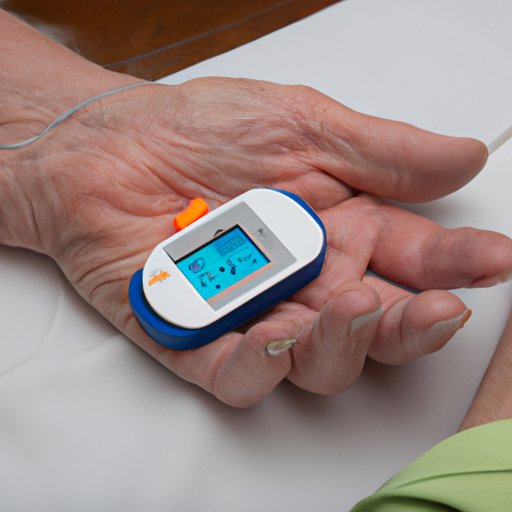Introduction
Pulse oximetry is a non-invasive medical procedure used to measure the amount of oxygen present in the bloodstream. The procedure involves attaching a device called a pulse oximeter to a patient’s finger or other body part. The oximeter uses two wavelengths of light to detect the oxygen saturation in the blood. This information can be used to assess the patient’s overall health and well-being.
Explaining the Science Behind Pulse Oximetry
Before we understand how a pulse oximeter works, let’s first discuss how oxygen is measured in the bloodstream. Oxygen is carried throughout the body by red blood cells. These cells contain hemoglobin, which is a protein responsible for carrying oxygen from the lungs to the rest of the body. When hemoglobin binds with oxygen, the resulting compound is known as oxyhemoglobin. A pulse oximeter measures the amount of oxyhemoglobin in the bloodstream.
The principles of pulse oximetry involve two main concepts: absorption and transmission. Absorption occurs when light passes through the skin and interacts with the hemoglobin molecules. As the light passes through, some of it is absorbed by the hemoglobin molecules. The amount of light absorbed depends on the amount of oxygen present in the blood. Transmission occurs when the remaining light is transmitted back through the skin. The pulse oximeter measures the amount of light that is transmitted, which indicates the oxygen saturation level in the blood.
An Overview of How a Pulse Oximeter Works
Now that we have a better understanding of the science behind pulse oximetry, let’s take a closer look at how a pulse oximeter works. The device consists of a probe that is attached to the patient’s finger or other body part. The probe contains two light sources — one red and one infrared — and two sensors that detect the amount of light that is transmitted through the skin. The light sources emit light into the tissue, and the sensors measure the amount of light that is transmitted back.
Once the light has been transmitted, the pulse oximeter calculates the oxygen saturation level in the blood. It does this by comparing the amount of light absorbed by the hemoglobin molecules to the amount of light that is transmitted back. The higher the oxygen saturation level, the more light is transmitted back. The readings are then displayed on the device’s screen in the form of a percentage.

The Benefits of Using Pulse Oximetry
Pulse oximetry offers many benefits to both patients and medical professionals. By providing accurate readings of oxygen saturation levels, pulse oximetry can help improve patient outcomes. It can also help medical professionals make faster, more informed decisions regarding patient care. Additionally, using pulse oximetry can reduce costs associated with monitoring patient vital signs, as it eliminates the need for costly and invasive tests.
The Different Types of Pulse Oximeters
Pulse oximeters come in a variety of shapes and sizes. Handheld oximeters are small and portable, making them ideal for use in hospitals and clinics. Wrist-worn oximeters are designed to be worn around the wrist, allowing for easy monitoring of oxygen saturation levels. Tabletop oximeters are larger devices that provide more detailed readings and are typically used for long-term monitoring.

Common Uses for Pulse Oximetry
Pulse oximetry is commonly used to monitor sleep apnea, as it can detect changes in oxygen saturation levels during sleep. It is also used to assess heart rate and rhythm, as well as to detect respiratory distress. In addition, pulse oximetry can be used to monitor patients with chronic conditions such as asthma and COPD.

Understanding the Readings on a Pulse Oximeter
When using a pulse oximeter, it’s important to understand what the numbers mean. Normal oxygen saturation levels range from 95% to 100%. If your readings are lower than this range, it could indicate a problem with your breathing or circulation. It’s important to consult your doctor if you experience any abnormal readings.
Conclusion
Pulse oximetry is a non-invasive medical procedure used to measure the amount of oxygen present in the bloodstream. The device consists of a probe that is attached to the patient’s finger or other body part, and emits two wavelengths of light to detect the oxygen saturation level in the blood. The readings are then displayed on the device’s screen in the form of a percentage. Pulse oximetry offers many benefits to both patients and medical professionals, including improved patient outcomes, increased efficiency for medical professionals, and cost savings.
There are several types of pulse oximeters available, including handheld, wrist-worn, and tabletop models. Pulse oximetry can be used to monitor a variety of conditions, including sleep apnea, heart rate and rhythm, and respiratory distress. When using a pulse oximeter, it’s important to understand what the numbers mean and to consult your doctor if you experience any abnormal readings.
(Note: Is this article not meeting your expectations? Do you have knowledge or insights to share? Unlock new opportunities and expand your reach by joining our authors team. Click Registration to join us and share your expertise with our readers.)
